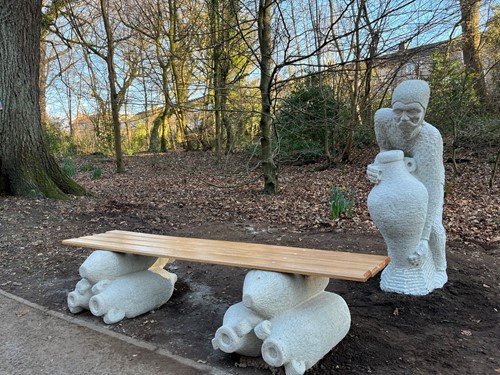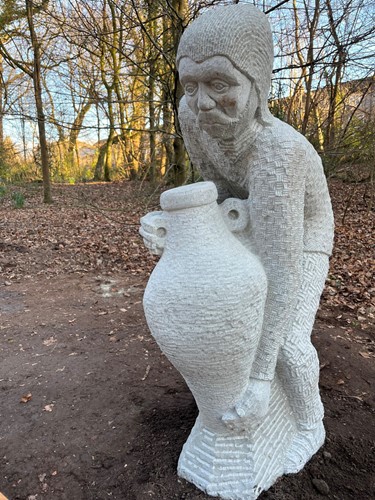Published 27 April 2023
A new stone bench and sculpture has been installed in Old Kilpatrick as part of a project to promote the area’s Roman heritage.
The installation at Lusset Glen was created by sculptor Gardner Molloy, and sits where the Antonine Wall, the most northerly point of the Roman Empire, passed through West Dunbartonshire.
Gardner’s design focuses on amphora storage pots, which were used by the Romans to store a wide variety of liquid and dry goods. They were popular at the time as they were robust, cheap and easy to make and could be stacked neatly into the holds of ships.
The bench legs are comprised of three stacked amphorae, and alongside it stands a carved figure who is picking up an amphora.


The feature was commissioned as part of the wider Rediscovering the Antonine Wall Project, which is being led by West Dunbartonshire Council in partnership with Historic Environment Scotland and the other authority areas the wall runs through.
The £2.1million project’s aim is to improve awareness and engagement with the site among local communities along the line of the Wall as well as from visitors from further afield.
Councillor Lawrence O’Neill, Chair of Planning at West Dunbartonshire Council, said: “I’m extremely proud to see our area’s Roman heritage recognised as part of this project, and hope this will lead to increased knowledge of this fascinating part of our history.
“This sculpture and bench is a great draw to Lusset Glen, and adds to a number of fantastic initiatives put in place to attract more people to learn about the Antonine Wall.”
Stephen Balfour, Rediscovering the Antonine Wall Project Manager, said: “This installation was only made possible through the participation of our partners. We are thankful for the support of Action Old Kilpatrick who were keen to highlight the area’s Roman heritage and were the driving force behind marking it in Lusset Glen. West Dunbartonshire Council Planning and Greenspace colleagues also provided assistance to help deliver the hand-crafted installation and we are delighted it has been so well received by the local community.”
West Dunbartonshire Council joined forces with Historic Environment Scotland and the other Council areas the wall passes through - Glasgow, East Dunbartonshire, North Lanarkshire and Falkirk – to bring the Wall’s fascinating story back to life with the Rediscovering project in 2018.
Since then, number of attractions have been installed along the Wall’s route including Roman themed play parks, designed with local schoolchildren, so children and young people can explore and play while finding out about its history; replica stone distance slabs and a giant Roman head sculpture.
